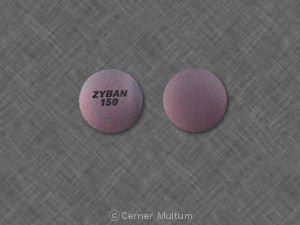Zyban Dosage
Generic name: BUPROPION HYDROCHLORIDE 150mg
Dosage form: tablet, film coated
Drug class: Smoking cessation agents
Medically reviewed by Drugs.com. Last updated on Jul 9, 2024.
Usual Dosage
Treatment with ZYBAN should be initiated before the patient’s planned quit day, while the patient is still smoking, because it takes approximately 1 week of treatment to achieve steady-state blood levels of bupropion. The patient should set a “target quit date” within the first 2 weeks of treatment with ZYBAN.
Dosing
To minimize the risk of seizure:
- •
- Begin dosing with one 150-mg tablet per day for 3 days.
- •
- Increase dose to 300 mg per day given as one 150-mg tablet twice each day with an interval of at least 8 hours between each dose.
- •
- Do not exceed 300 mg per day.
ZYBAN should be swallowed whole and not crushed, divided, or chewed, as this may lead to an increased risk of adverse effects including seizures.
ZYBAN may be taken with or without food.
Duration of Treatment
Treatment with ZYBAN should be continued for 7 to 12 weeks. If the patient has not quit smoking after 7 to 12 weeks, it is unlikely that he or she will quit during that attempt so treatment with ZYBAN should probably be discontinued and the treatment plan reassessed. The goal of therapy with ZYBAN is complete abstinence.
Discuss discontinuing treatment with ZYBAN after 12 weeks if the patient feels ready but consider whether the patient may benefit from ongoing treatment. Patients who successfully quit after 12 weeks of treatment but do not feel ready to discontinue treatment should be considered for ongoing therapy with ZYBAN; longer treatment should be guided by the relative benefits and risks for individual patients.
It is important that patients continue to receive counseling and support throughout treatment with ZYBAN and for a period of time thereafter.
Individualization of Therapy
Patients are more likely to quit smoking and remain abstinent if they are seen frequently and receive support from their physicians or other healthcare professionals. It is important to ensure that patients read the instructions provided to them and have their questions answered. Physicians should review the patient’s overall smoking cessation program that includes treatment with ZYBAN. Patients should be advised of the importance of participating in the behavioral interventions, counseling, and/or support services to be used in conjunction with ZYBAN.
Patients who fail to quit smoking during an attempt may benefit from interventions to improve their chances for success on subsequent attempts. Patients who are unsuccessful should be evaluated to determine why they failed. A new quit attempt should be encouraged when factors that contributed to failure can be eliminated or reduced, and conditions are more favorable.
Maintenance
Tobacco dependence is a chronic condition. Some patients may need ongoing treatment. Whether to continue treatment with ZYBAN for periods longer than 12 weeks for smoking cessation must be determined for individual patients.
Combination Treatment with ZYBAN and a Nicotine Transdermal System (NTS)
Combination treatment with ZYBAN and NTS may be prescribed for smoking cessation. The prescriber should review the complete prescribing information for both ZYBAN and NTS before using combination treatment. Monitoring for treatment‑emergent hypertension in patients treated with the combination of ZYBAN and NTS is recommended.
Dose Adjustment in Patients with Hepatic Impairment
In patients with moderate to severe hepatic impairment (Child-Pugh score: 7 to 15), the maximum dose should not exceed 150 mg every other day. In patients with mild hepatic impairment (Child-Pugh score: 5 to 6), consider reducing the dose and/or frequency of dosing.
Dose Adjustment in Patients with Renal Impairment
Consider reducing the dose and/or frequency of ZYBAN in patients with renal impairment (Glomerular Filtration Rate less than 90 mL per min).
Use of ZYBAN with Reversible MAOIs Such as Linezolid or Methylene Blue
Do not start ZYBAN in a patient who is being treated with a reversible MAOI such as linezolid or intravenous methylene blue. Drug interactions can increase the risk of hypertensive reactions.
In some cases, a patient already receiving therapy with ZYBAN may require urgent treatment with linezolid or intravenous methylene blue. If acceptable alternatives to linezolid or intravenous methylene blue treatment are not available and the potential benefits of linezolid or intravenous methylene blue treatment are judged to outweigh the risks of hypertensive reactions in a particular patient, ZYBAN should be stopped promptly, and linezolid or intravenous methylene blue can be administered. The patient should be monitored for 2 weeks or until 24 hours after the last dose of linezolid or intravenous methylene blue, whichever comes first. Therapy with ZYBAN may be resumed 24 hours after the last dose of linezolid or intravenous methylene blue.
The risk of administering methylene blue by non-intravenous routes (such as oral tablets or by local injection) or in intravenous doses much lower than 1 mg per kg with ZYBAN is unclear. The clinician should, nevertheless, be aware of the possibility of a drug interaction with such use.
Frequently asked questions
- How long does it take Wellbutrin XL/SR (bupropion) to work?
- Does Auvelity work better than Wellbutrin?
- Auvelity vs. Wellbutrin: Effectiveness for Depression?
More about Zyban (bupropion)
- Check interactions
- Compare alternatives
- Reviews (129)
- Drug images
- Side effects
- During pregnancy
- Drug class: smoking cessation agents
- Breastfeeding
Patient resources
Other brands
Wellbutrin, Wellbutrin XL, Wellbutrin SR, Aplenzin, ... +4 more
Professional resources
Other brands
Wellbutrin, Wellbutrin XL, Wellbutrin SR, Aplenzin, Forfivo XL
Related treatment guides
Further information
Always consult your healthcare provider to ensure the information displayed on this page applies to your personal circumstances.


